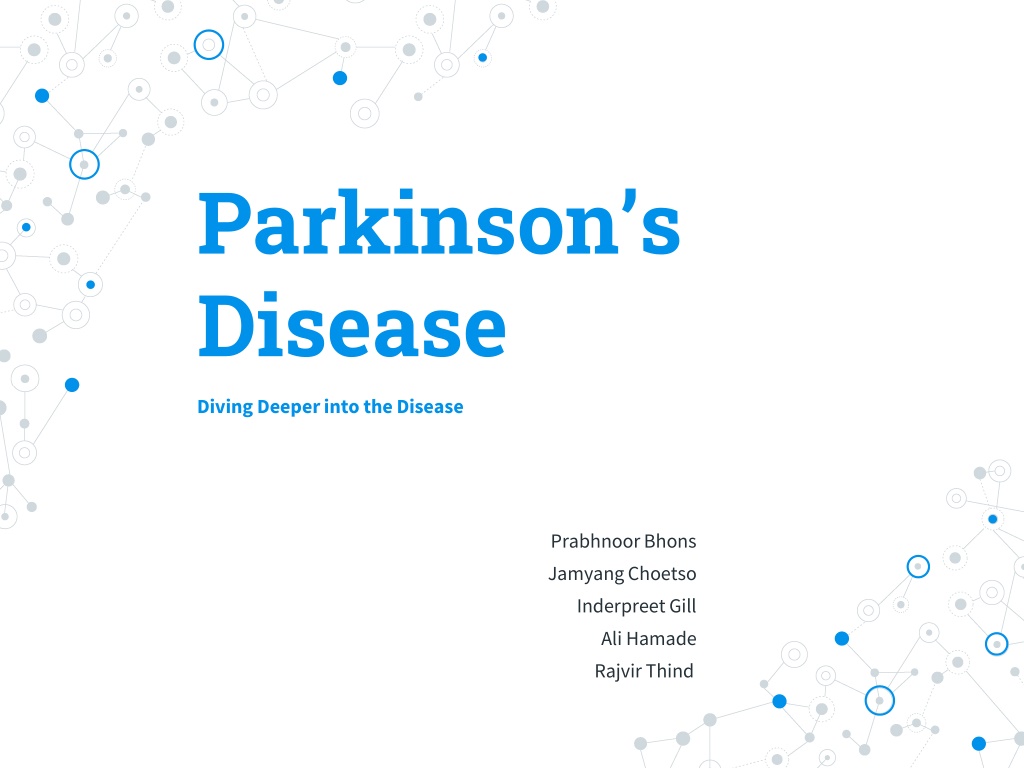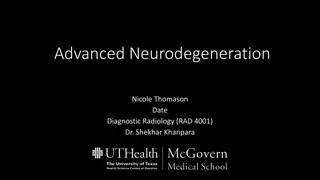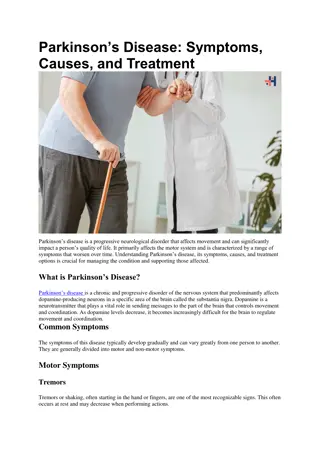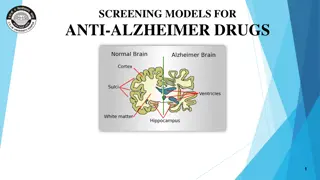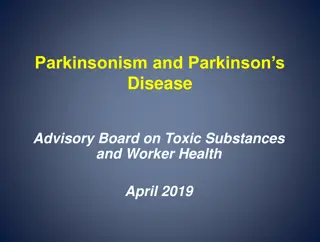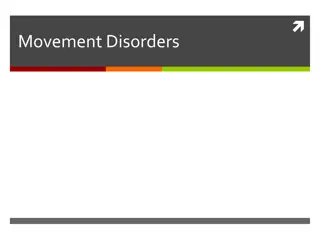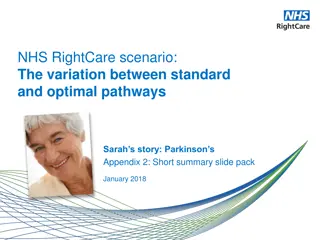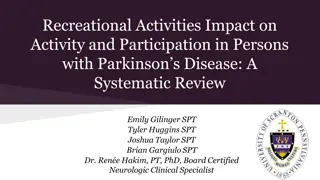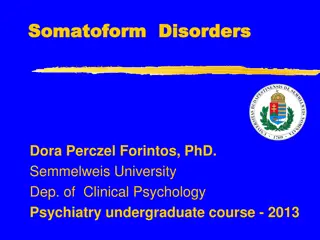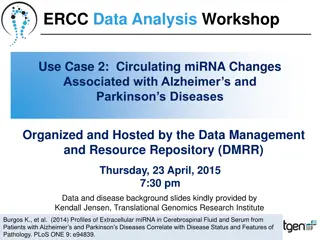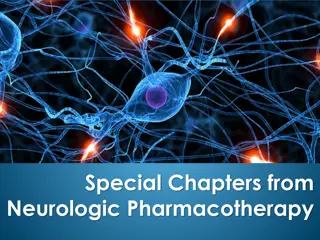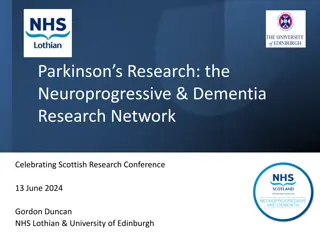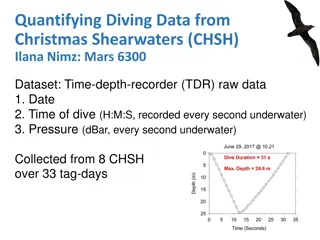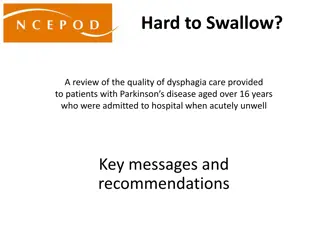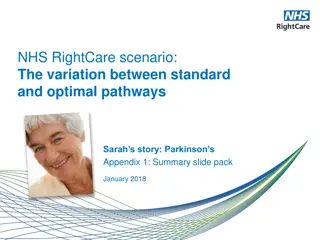Understanding Parkinson's Disease: Diving Deeper into the Neurodegenerative Disorder
Parkinson's disease is a neurodegenerative disorder that impacts dopamine levels in the brain. The history, epidemiology, causes, and pathophysiology of the disease are explored, shedding light on its significant impact on the nervous system. Genetic and environmental factors play a role in the development of Parkinson's, leading to the deterioration of neurons in the substantia nigra and a decrease in dopamine production. Understanding the complexities of this disease is crucial for effective management and treatment strategies.
Download Presentation

Please find below an Image/Link to download the presentation.
The content on the website is provided AS IS for your information and personal use only. It may not be sold, licensed, or shared on other websites without obtaining consent from the author. Download presentation by click this link. If you encounter any issues during the download, it is possible that the publisher has removed the file from their server.
E N D
Presentation Transcript
Parkinsons Disease Diving Deeper into the Disease Prabhnoor Bhons Jamyang Choetso Inderpreet Gill Ali Hamade Rajvir Thind
Parkinson s disease is a neurodegenerative disorder which affects dopamine levels1 Image: https://www.clinicaladvisor.c om/features/link-between- pesticides-and-parkinsons- disease/article/492896/ 2
History2,3,4 1895 Richer and Beige Stages of the disease 1817 James Parkinson Essay on the shaking palsy Jean-Martin Charcot Parkinson s disease" 3
History2,3,4 Brissaud PD and damage to the substantia nigra" 1953 Greenfield and Bosanquet Comprehensive analysis Tr tiakoff, Foix, and Nicolesco midbrain Babinski Irregular motor fluctuations 4
Epidemiology3,5,6,7,8,9 Most common movement disorder 2ndmost common neurodegenerative disease Affects 1-2 people for every 1000 In US: 572 per 100,000 5
Epidemiology9 1602 / 100,00 1602 / 100,00 646 / 100,00 1602 / 100,00 6
Causes10,11,12 Neurons in substantia nigra deteriorate Decrease in dopamine Cause not known but believed to be genetic or environmental Genetic: LRRK2, PARK7, PINK1, PRKN, or SNCA Environmental: pesticide, tobacco smoke, head injury 7
Pathophysiology13,14,15,16 Substantia Nigra plays a role in movement Moves through the brain via synaptic transmission Seen in much lower levels in PD Image:https://www.forbes.com/sites/daviddisalvo/201 2/06/05/the-straight-dope-on-what-bath-salts-do-to- your-brain-and-why-theyre-dangerous/#3ce350f978ed 9
Pathophysiology17,18,19,20,21 Substantia Nigra can inhibit or excite unwanted movement. PD develops when at 80% of the neurons die Image:https://sci ensphere.wordpr ess.com/2015/08/ 15/how-are- parkinsons- disease-and- huntingtons- disease-different/ Lewy bodies 10
Symptom s
Motor Symptoms22,23 Affect mobility T: tremors R: rigidity A: akinesia P:postural instability Image: https://labiotech.eu/medical/axovant-parkinsons-disease-gene/ 12
Non-Motor Symptoms24 Not visible Autonomic Neuropsychiatric disorders dysfunction Sleep disorders Sensory abnormalities Image: http://www.youandparkinsons.com/en-pk/view/m101-s01-understanding-parkinsons-disease-slide-show 13
PD is commonly misdiagnosed, either missing it completely or telling someone they have it, even if they don t24 15
UK Brain Bank Criteria26 3. Supportive Criteria 1. Diagnosis of Parkinsonian 2. Exclusion Criteria 16
MDS -UPDRS25 Neuroimaging23 Movement Disorders Society - Unified Parkinson s Disease Rating Scale questionnaire CT Scan MRI PET SPECT 17
Drugs and Medications
1. Levodopa (L-dopa)27 One of the most prominent drugs Amino acid that is involved in dopamine producing pathway Side effects: Nausea Involuntary movement Mood swings 19
2. Dopamine Agonist (DA)27,28 Discovered by Calne and colleagues in 1970 s Bypass the degenerating dopaminergic pathway Do not produce toxic metabolites or free radicals Ropinirole Side effects: Vomiting Hypotension Hallucinations for PD patients with dementia 20
3. MAO-B Inhibitors27 Blocks the metabolism of dopamine Block the conversion of MPTP to its active metabolic MPP+ Selegiline was the first MAO-B inhibitor Side effects: Headache Loss of balance Nausea Image: https://scienceofparkinsons.c om/tag/mao-b-inhibitors/ 21
Future Therapeutics
Future Therapeutics29,30,31,32 1. A2A antagonists 2. Gene Therapy a. Neurturin b. GABA 3. Levodopa/carbidopa 4. AFQ056 23
References 1. Poewe W, Seppi K, Tanner CM, Halliday GM, Brundin P, Volkmann J, Schrag AE, Lang AE. Parkinson disease. Nature reviews Disease primers. 2017 Mar 23;3:17013. Goetz CG. The history of Parkinson's disease: early clinical descriptions and neurological therapies. Cold Spring Harbor perspectives in medicine. 2011 Sep 1;1(1):a008862. Tysnes OB, Storstein A. Epidemiology of Parkinson s disease. Journal of Neural Transmission. 2017 Aug 1;124(8):901-5. Gelb DJ, Oliver E, Gilman S. Diagnostic criteria for Parkinson disease. Archives of neurology. 1999 Jan 1;56(1):33-9. von Campenhausen S, Bornschein B, Wick R, B tzel K, Sampaio C, Poewe W, Oertel W, Siebert U, Berger K, Dodel R. Prevalence and incidence of Parkinson's disease in Europe. European Neuropsychopharmacology. 2005 Aug 1;15(4):473-90. De Lau LM, Breteler MM. Epidemiology of Parkinson's disease. The Lancet Neurology. 2006 Jun 1;5(6):525-35. De Rijk MC, Breteler MM, Graveland GA, Ott A, Grobbee DE, Van der Meche FG, Hofman A. Prevalence of Parkinson's disease in the elderly The Rotterdam Study. Neurology. 1995 Dec 1;45(12):2143-6. Launer LJ, Berger K, Breteler MM, Dartigues JF, Baldereschi M, Fratiglioni L, Lobo A, Martinez-Lage J, Trenkwalder C, Hofman A. Prevalence of Parkinson's disease in Europe: A collaborative study of population-based cohorts. Neurologic Diseases in the Elderly Research Group. Neurology. 2000;54(11 Suppl 5):S21-3. Marras C, Beck JC, Bower JH, Roberts E, Ritz B, Ross GW, Abbott RD, Savica R, Van Den Eeden SK, Willis AW, Tanner CM. Prevalence of Parkinson s disease across North America. NPJ Parkinson's disease. 2018 Jul 10;4(1):21. Schapira AH, Jenner P. Etiology and pathogenesis of Parkinson's disease. Movement disorders. 2011 May;26(6):1049-55. Li JY, Englund E, Holton JL, Soulet D, Hagell P, Lees AJ, Lashley T, Quinn NP, Rehncrona S, Bj rklund A, Widner H. Lewy bodies in grafted neurons in subjects with Parkinson's disease suggest host-to-graft disease propagation. Nature medicine. 2008 May;14(5):501. Camargos ST, Dornas LO, Momeni P, Lees A, Hardy J, Singleton A, Cardoso F. Familial Parkinsonism and early onset Parkinson's disease in a Brazilian movement disorders clinic: phenotypic characterization and frequency of SNCA, PRKN, PINK1, and LRRK2 mutations. Movement Disorders. 2009 Apr 15;24(5):662-6. Filion M. Abnormal spontaneous activity of globus pallidus neurons in monkeys with MPTP-induced parkinsonism. Brain research. 1991 Apr 26;547(1):140-4. DeLong MR. Primate models of movement disorders of basal ganglia origin. Trends in neurosciences. 1990 Jul 1;13(7):281-5. Vallone D, Picetti R, Borrelli E. Structure and function of dopamine receptors. Neuroscience & biobehavioral reviews. 2000 Jan 1;24(1):125- 32. 2. 3. 4. 5. 6. 7. 8. 9. 10. 11. 12. 13. 14. 15. 24
References 16. Ribrault C, Sekimoto K, Triller A. From the stochasticity of molecular processes to the variability of synaptic transmission. Nature Reviews Neuroscience. 2011 Jul;12(7):375. Zarow C, Lyness SA, Mortimer JA, Chui HC. Neuronal loss is greater in the locus coeruleus than nucleus basalis and substantia nigra in Alzheimer and Parkinson diseases. Archives of neurology. 2003 Mar 1;60(3):337-41. Deumens R, Blokland A, Prickaerts J. Modeling Parkinson's disease in rats: an evaluation of 6-OHDA lesions of the nigrostriatal pathway. Experimental neurology. 2002 Jun 1;175(2):303-17. Greenwood CE, Tatton WG, Seniuk NA, Biddle FG. Increased dopamine synthesis in aging substantia nigra neurons. Neurobiology of aging. 1991 Sep 1;12(5):557-65. Auluck PK, Chan HE, Trojanowski JQ, Lee VM, Bonini NM. Chaperone suppression of -synuclein toxicity in a Drosophila model for Parkinson's disease. Science. 2002 Feb 1;295(5556):865-8. Jankovic J. Parkinson s disease: clinical features and diagnosis. Journal of neurology, neurosurgery & psychiatry. 2008 Apr 1;79(4):368-76. Reichmann H. Clinical criteria for the diagnosis of Parkinson s disease. Neurodegenerative diseases. 2010;7(5):284-90. Weintraub D, Comella CL, Horn S. Parkinson's disease--Part 1: Pathophysiology, symptoms, burden, diagnosis, and assessment. Am J Manag Care. 2008 Mar 1;14(2 Suppl):S40-8. Marsili L, Rizzo G, Colosimo C. Diagnostic Criteria for Parkinson s Disease: From James Parkinson to the Concept of Prodromal Disease. Frontiers in neurology. 2018 Mar 23;9:156. Davie CA. A review of Parkinson's disease. British medical bulletin. 2008 Apr 8;86(1):109-27. Lang AE, Lees A. Management of Parkinson s disease: an evidence-based review. Mov Disord. 2002 Jan 1;17(Suppl 4):S1-66. Nutt JG, Wooten GF. Diagnosis and initial management of Parkinson's disease. New England Journal of Medicine. 2005 Sep 8;353(10):1021- 7. van Rensburg HJ, Legoabe L, Terre Blanche G, Van der Walt M. 2 Benzylidene 1 Indanone Analogues as Dual Adenosine A1/A2a Receptor Antagonists for the Potential Treatment of Neurological Conditions. Drug research. 2019 Jan 7. Palmer C, Coronel R, Bernabeu-Zornoza A, Liste I. Therapeutic Application of Stem Cell and Gene Therapy in Parkinson s Disease. InPathology, Prevention and Therapeutics of Neurodegenerative Disease 2019 (pp. 159-171). Springer, Singapore. Anang JB. Levodopa-Carbidopa-Related Rash in Parkinson s Disease: A Case Series. Canadian Journal of Neurological Sciences. 2018 Sep;45(5):588-9. Jones T, Murray R. Current research in and development of treatments for Parkinson s disease. Pathophysiology. 2018 Dec 11;14:00. 17. 18. 19. 20. 21. 22. 23. 24. 25. 26. 27. 28. 29. 30. 31. 25
